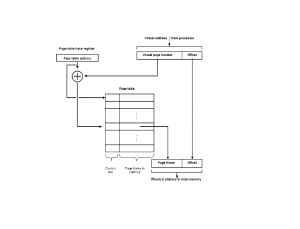What is address translation ?
Companies Related Questions, Computer Archtecture 0 CommentsThe process of translating a virtual address into physical address is known as address translation. It can be done with the help of MMU. A simple method for translating virtual addresses into physical addresses is to assume that all programs and data are composed of fixed-length units called pages, each of which consists of a block of words that occupy contiguous locations in the main memory. Pages commonly range from 2K to 16K bytes in length. They constitute the basic unit of information that is moved between the main memory and the disk whenever the translation mechanism determines that a move is required. Pages should not be too small, because the access time of a magnetic disk is much longer (several milliseconds) than the access time of the main memory. The reason for this is that it takes a considerable amount of time to locate the data on the disk, but once located, the data can be transferred at a rate of several megabytes per second. On the other hand, if pages are too large it is possible that a substantial portion of a page may not be used, yet this unnecessary data will occupy valuable space in the main memory.

The cache bridges the speed gap between the processor and the main memory and is implemented in hardware. The virtual-memory mechanism bridges the size and speed gaps between the main memory and secondary storage and is usually implemented in part by software techniques. Conceptually, cache techniques and virtual- memory techniques are very similar. They differ mainly in the details of their implementation.
A virtual-memory address translation method based on the concept of fixed-length pages is shown schematically in Figure 4.20. Each virtual address generated by the processor, whether it is for an instruction fetch or an operand fetch/store operation, is interpreted as a virtual page number (high-order bits) followed by an offset (low-order bits) that specifies the location of a particular byte (or word) within a page. Information about the main memory location of each page is kept in a page table. This information
includes the main memory address where the page is stored and the current status of the page. An area in the main memory that can hold one page is called a page frame. The starting address of the page table is kept in a page table base register. By adding the virtual page number to the contents of this register, the address of the corresponding entry in the page table is obtained. The contents of this location give the starting address of the page if that page currently resides in the main memory. Each entry in the page table also includes some control bits that describe the status of the page while it is in the main memory. One bit indicates the validity of the page, that is, whether the page is actually loaded in the main memory. This bit allows the operating system to invalidate the page without actually removing it. Another bit indicates whether the page has been modified during its residency in the memory. As in cache memories, this information is needed to determine whether the page should be written back to the disk before it is removed from the main memory to make room for another page. Other control bits indicate various restrictions that may be imposed on accessing the page. For example, a program may be given full read and write permission, or it may be restricted to read accesses only.